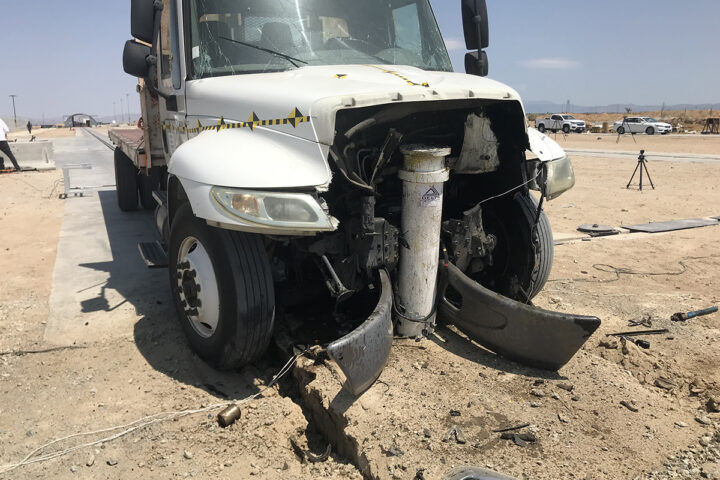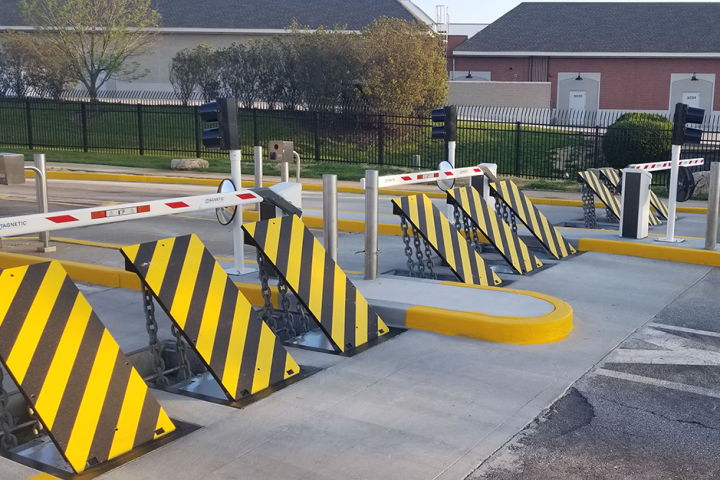Delta Scientific announces the successful testing of its ASTM F2656-20 M30/P1-certified Model DSC633, a single shallow foundation bollard design that stops and destroys a 15,000 (6.804 kg) pound test truck with -8.82 feet (-2.69 m) of static penetration and -3.63 feet (-1.1 m) of dynamic penetration. The simulated bomb load remained intact and contained on the truck bed. The test vehicle weighed 15,000 pounds (6,804 kg) and was traveling over 30 miles per hour (48 kpm). The truck was stopped and completely disabled.
Overview of Delta’s Maintenance Services and Technical Support
We are confident that you will be satisfied with the purchase of your security barricades from Delta Scientific. However, your relationship with us doesn’t have to end following installation. We stand behind our products and continue to provide technical support and maintenance services even after the purchase is complete. If you run into any difficulties following the purchase and installation of your product, we encourage you to contact us to discuss any questions, concerns, or problems you have with the product.
Product Spotlight: DSC720-1M Tall High Security Bollards
The highest crash-rated bollard that we offer at Delta Scientific is the DSC720. With a crash rating of K-12, its height of 35 inches is sufficient to stop most large vehicles. However, in Europe and the Middle East, truck cabs are taller than in the United States. Because these taller models can be top-heavy, they may tumble over standard bollards and cause damage even after bringing the vehicle to a halt.
Understanding Barrier Crash Ratings
Delta Scientific’s high-security barricades meet or exceed standards for the industry as evidenced by our crash ratings. However, unless you understand what the ratings mean, you cannot really appreciate how effective our barriers are. For this reason, we feel that it may be helpful to explain the crash ratings behind our products and what they mean.
Overview of Permanent High-Security Solutions From Delta Scientific
Different types of facilities have different security needs. Facilities where dangerous or critical operations take place, such as government facilities, power plants, warehouses, or airports, need a greater level of protection. Delta Scientific offers a range of high-security products to meet the unique needs of your establishment. Here is an overview of our permanent high-security solutions.
Our Fastest, Smallest, Shallowest Barricade: DSC2000
As terrorists become more emboldened and the threat of vehicle attacks increases, a crash-rated barricade becomes more necessary, especially for government buildings and other sensitive facilities. However, there are difficulties involved in transporting and installing many barricades. For one thing, if the facility is in a remote location, transporting the heavy equipment to the site can be a challenge. Conversely, if the facility is in a well-established and developed area, it is difficult to install the barricade without disturbing underground utilities and other buried elements.
Advantages of Custom Engineering for Physical Security Products
Delta Scientific products are thoroughly tested and certified to meet or exceed standards set by ASTM International and the United States Department of Defense. We are confident in the level of protection that our products provide. Nevertheless, we realize that an off-the-shelf solution doesn’t always work for every individual situation, regardless of how effective it may be in general. Every barrier project we do involves our team of engineers, who are happy to address real-world challenges and work with our clients to devise a solution. Here are a few of the ways that you can benefit from taking advantage of custom engineering for your project.
A Look at Delta Scientific’s New Product: The Anti-Climb Pedestrian Door
Installing effective security infrastructure on your property involves a thorough risk assessment and deploying a comprehensive solution that takes all possible threats into consideration. For example, if your security solution only addresses the threat of vehicular attack and disregards the risk associated with pedestrian trespassers, you may be leaving yourself unnecessarily vulnerable to breaches by unauthorized personnel on foot.
The Future of Outdoor Dining After the Pandemic
Designing a secure location can be a challenge, but having to do so in the midst of a bustling metropolis poses even bigger issues. Along with needing to keep the building and its occupants safe from vehicular and personal intrusion, architects will also have to keep the local population in mind. While redesigning and adding to their second corporate headquarters, these are exactly the problems Amazon has to face in Arlington, VA. Fortunately, the company has an excellent model that integrates state-of-the-art security with a park-like landscape.
How Crash-Rated Barriers From Delta Scientific Provide Security and Peace of Mind
It has been over 25 years since the attack on the Murrah Federal Building in Oklahoma City, one of the most significant terrorist attacks involving a vehicle up to that point. The world seems more dangerous now in many ways. News stories about terrorists weaponizing vehicles by driving them at high speeds into pedestrian areas as outdoor events are becoming more commonplace.










